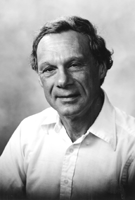Obituaries: Julian Cole
June 23, 1999

Julian D. Cole, 1925-1999
He was honored many times throughout his career for excellence, including simultaneous election to the National Academy of Engineering and the National Academy of Sciences in 1976. He was named a Fellow of the American Physical Society, of the American Institute of Aeronautics and Astronautics, and of the American Academy of Arts and Sciences. Among other awards, he received the Theodore von K�rm�n Prize (SIAM), the Award for Meritorious Civilian Service (Air Force), the Fluid Dynamics Award (AIAA), and the National Academy of Sciences Award in Applied Mathematics and Numerical Analysis. Julian will be best remembered professionally for his seminal research and for his books: Perturbation Methods in Applied Mathematics (1968, followed by a successor in 1981 and another, Multiple Scales and Singular Perturbation Methods, in 1996, both with Kevorkian); Transonic Aerodynamics (1986, with Cook); and Similarity Methods for Differential Equations (1974, with Bluman). His professional career was brilliantly reviewed by Marshall Tulin in "Julian David Cole---A Scientific Biography," the introduction to Mathematics Is for Solving Problems (SIAM, 1996). This is a must-read for any aspiring applied mathematician and for any devotee of Julian's work.
Marshall surveys the development and the significance of Julian's work, creating a profile of a career. In his words:
"Julian's early experience in bringing mathematics forcefully to bear on important, current engineering problems took place at GALCIT [the Guggenheim Aeronautical Laboratories, at Caltech], the very laboratory where von K�rm�n translated his own tradition in America. The heart of that tradition was a deep commitment to the scientific formulation and mathematical solution of real engineering problems, rather than to the development of mathematics for its own sake. . . . Here the importance of historical and exemplary figures like Rayleigh and Kelvin in the last century and Timoshenko, Burgers, and von K�rm�n in the first half of this century is crucial. In the second half of this century, Julian Cole certainly takes his place with his predecessors. Von K�rm�n had clearly understood and publicized the vast and mostly uncharted territory of nonlinear phenomena looming ahead in engineering, and it was the heart of this territory in aerodynamics, transonics, which Julian conquered. . . . What sets Julian aside from many other engineers using theory is the depth and general applicability of the mathematical tools which he has devised for the solution of problems. In this respect, his body of work is exceptional."Julian was notable for his patience, persistence, and integrity. He was accepting of others' faults, and he was a wise man. He thought about mathematics continually and was always ready for technical questions and discussions. He was a role model, a man whose mind was sharp and who was able to see through problems quickly, but yet a man who remained diffident and humble. He was a great researcher, but even more a superb teacher. He was an absorbing lecturer. He was generous with his time, and generous and open with his thoughts and ideas. He could get to the heart of any problem and distill it to its relevant and simplified components!
It is no surprise, then, that Julian had so many collaborators and guided 38 PhD theses to completion. Those of us who are lucky enough to have known and to have worked with Julian, including his students, are deeply indebted to him for our outlook on our work and on our lives.
Julian shared with many of us information gleaned from his voracious reading. Many of us spent time at the racetrack with him, learning how to read the Daily Racing Form and how to bet on horses. Some of us remember sitting through an initially frightening earthquake as Julian calmly and soothingly continued to lecture. Some remember a seminar (on the inner ear) in the Doctors' Lounge at the UCLA Hospital, with Julian in hospital patient's garb, until the nurses asked us to leave. (That was after Julian's infamous attempt at motorcycling.) He enjoyed food, wine, and music, and most of us shared a memorable meal with him. Julian was a hiker, a skier, and a runner who ran virtually everyday of his life. He was a devoted father who was proud of his children.
His love of and dedication to his profession never failed, and despite his illness, Julian was teaching and initiating research collaborations until the time of his death. He was at that time the Margaret Darrin Distinguished Professor of Applied Mathematics at RPI, where he had been a member of the faculty for the past 17 years and where his wife, Sue, is also a faculty member in applied mathematics.
Pam Cook (University of Delaware), Marshall Tulin (University of California, Santa Barbara), and Joe Flaherty (RPI), on behalf of Julian's many colleagues and friends.

